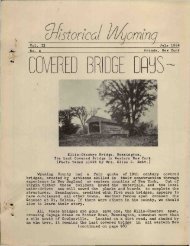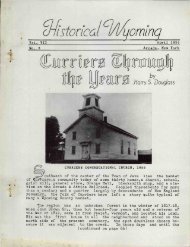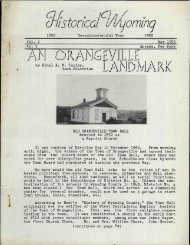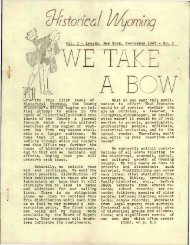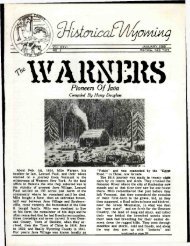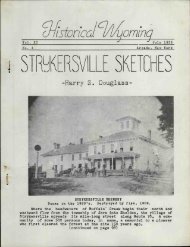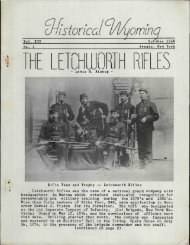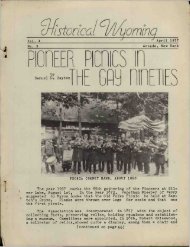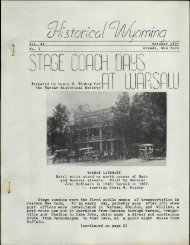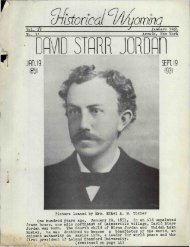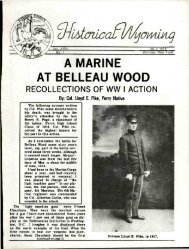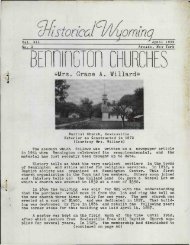By C. Kihm Richardson Walking from Strykersville ... - Fulton History
By C. Kihm Richardson Walking from Strykersville ... - Fulton History
By C. Kihm Richardson Walking from Strykersville ... - Fulton History
You also want an ePaper? Increase the reach of your titles
YUMPU automatically turns print PDFs into web optimized ePapers that Google loves.
APRIL 1978 .<br />
Memories of Java and <strong>Strykersville</strong> (continued)<br />
I was born in 1908 but I don't remember even<br />
seeing an automobile until about 1914. Some automobiles<br />
had ventured out to the Java area before<br />
that but roads into Buffalo had only recently been<br />
hard surfaced, side roads were not even good<br />
gravel. Moving of materials such as gravel onto<br />
roads had to be accomplished with horse and wagon.<br />
Such things as auto agencies, gas stations, garages<br />
were practically non-existent in the country. Sears<br />
Roebuck had earlier sold automobiles by catalog;<br />
this was a buggy wheel type delivered by railway<br />
car to the local area. The first gasoline pump I<br />
remember was a one gallon piston and cylinder<br />
type. The garage mechanic had rigged up a rod to<br />
push a ball bearing over into a hopper on each<br />
stroke so there could be no mik up on the amount<br />
pumped. Another early pump had a glass container<br />
of 5 to 10 gallons on top of the pump where the<br />
gas was pumped and measured, then drained into<br />
the automobile tank.<br />
Gasoline was used for stationary gasoline engines<br />
before automobiles madetheirway into this area, so<br />
gasoline and kerosene were delivered by horse<br />
drawn vehicles. The various different shaped one<br />
gallon cans had not yet been produced. Syrup cans<br />
were avilable at any hardware store, in fact, made<br />
at Java Village. This resulted in their being used<br />
for many purposes such as lubricating oil as it was<br />
called then rather that motor oil. This resulted in<br />
some problems, one I know of when syrup was inadvertently<br />
added to the crankcase of the first<br />
small dump truck bought by the town where I lived.<br />
As soon as the syrup and oil mixture was heated,<br />
the syrup candied and after the engine had been<br />
stopped and allowed to cool the pistons were stuck<br />
solid. Only by steaming the disassembled engine<br />
was it possible to use it again. Of course the cause<br />
of the trouble was not known until they had this<br />
engine all torn to pieces and the problem was traced<br />
back to the syrup.<br />
Automobiles were not nearly so dependable as<br />
in later years. Broken axles were not uncommon,<br />
engines were overhauled every 3 or 10 thousand<br />
miles; did they need it? I have always had a question<br />
in my mind. After being overhauled they were<br />
towed because the rings, pistons and bearings were<br />
set up so tight. Bearings were of babbeted type,<br />
scraped to fit.<br />
The automobile manufacturers by 1912 began<br />
experimenting with methods of starting other than<br />
by crank. There were other methods than with an<br />
electric motor, such as compressed air and a<br />
combustible gas stored in a cylinder. The cheap<br />
cars did not go in for this added feature for some<br />
years but for one well known make you could buy<br />
a rachet and a cable that could be pulled <strong>from</strong><br />
inside the car to give the engine a quarter turn,<br />
this would have been in the 20's. 1912 saw the<br />
start of enclosed cars, but open cars with their<br />
side curtains continued to predominate for many<br />
years.<br />
PAGE 89<br />
Headlights were probably originally oil but the<br />
first I remember were acetyline supplied <strong>from</strong> a<br />
cylinder on the running board. The first electric<br />
lights that I remember ran off a magneto, and if<br />
the lights were too dim, you released the clutch<br />
to let the engine speed up to give a burst of light.<br />
Tires were a problem, I mean really a problem,<br />
until they started making what they called cord<br />
tires about the time of the first World War; even<br />
these left some thing to be desired. The cemented<br />
fabric type that woulci heat and fail because the<br />
layers were not vulcanized to each other continued<br />
in use for a time after that. Earlier cars were advertised<br />
as equipped with a tube patching outfit. A<br />
trip of any distance like 50 miles was expected to<br />
include patching tires.<br />
In the early 20's a great achievement with a car<br />
was being able to go up a hill such as the one to<br />
Java Center in high gear. This was what is now<br />
called Pitt Road, at that time the only road to<br />
Java Center. The new road was built in about 1928<br />
following some of the route that had been planned<br />
for the electric railway of about 1900.<br />
Pictured is Mrs. Lena <strong>Kihm</strong> the maternal<br />
grandmother of the author. '<br />
The four wheel brakes and actuation by hydraulics<br />
came along in the 20's. Of course when they first<br />
came out there were those who argued that having<br />
brakes on the front wheels would never work out.<br />
Automobiles have improved since the 20's with<br />
higher compression, better tires, lower suspension<br />
because of better roads, but the advancement<br />
there has been small compared with the airplane,<br />
television, travel to the moon, electronics,<br />
etc. These have all made greater and greater use<br />
of fossil produced energy in lieu of the sweat of the<br />
human brow or animals to raise the standard of<br />
living. Who knows how long this will last?<br />
(continued on page 90)



